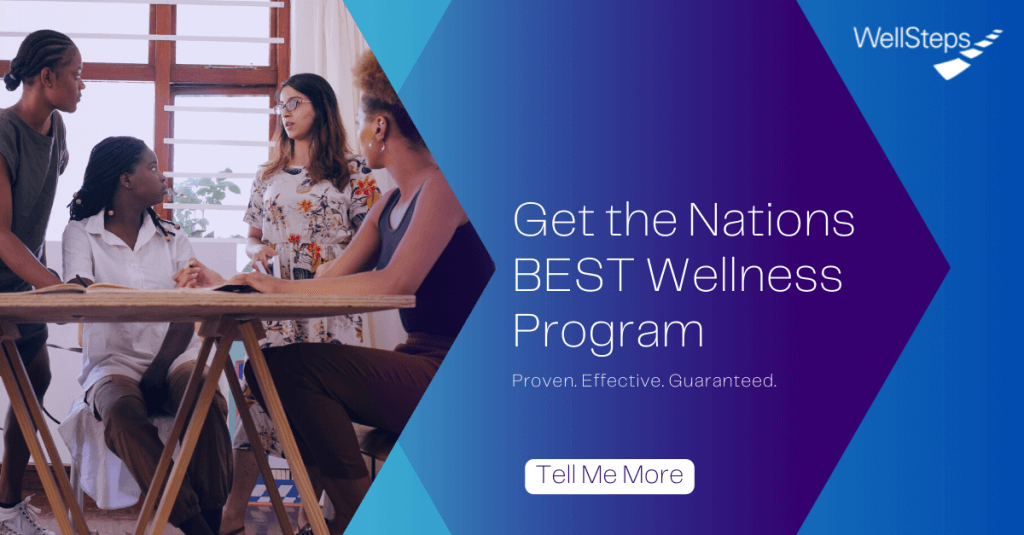The one ingredient that makes employee wellness programs successful is engagement.
Workplaces can keep crafting new programs for their employees but if there are no takers, they may as well scream into the void. A high-engagement wellness program is one that brings employees along for the ride.
When employees are happier and healthier, morale and productivity improve. In turn, organizations reduce healthcare costs and employee turnovers—each of which is estimated to cost up to 33% of an employee’s annual salary.

So, what are the elements of a successful wellness program? And what features can be included to engage employees?
Let’s take a look at 15 actionable steps to enhance employee participation in wellness programs.
Idea 1: Tailored Wellness Challenges Increase Engagement
Know your audience. A well designed, custom wellness program for employees may work great for one company but may need to adjustments to ensure success at another company. An important guideline to remember is that your initiatives should be tailored to your employees’ needs and interests.
Does your workforce love to go on walks? Introduce a step challenge where they have to complete a certain number of steps per day. Are they interested in eating more healthily? Try a nutrition challenge.
There are lots of challenges you can implement but it’s important to consider the people who will be joining them. WellSteps has a handy Checklist to Change to help guide your efforts. When employee population and workplace culture are considered, your program will have increased impact.
Idea 2: Gamify Wellness Goals For High Engagement
The gamification of health has already been explored by experts in detail. Turning wellness programs into fun games or challenges is known to result in:
- Improved engagement
- Increased motivation
- Better retention
What would gamification look like in practice?
It could send employees on a virtual treasure hunt, where the winner—who takes the most steps over a specified period—wins the prize. Alternatively, it could present employees with a virtual maze that can only be navigated when a player eats a particular fruit every day for a week.

Wellness games should be crafted to cater to employees. This improves engagement while encouraging stronger social connections.
Popular apps like Strava or Water Minder take advantage of leaderboards, progress bars, and rewards to promote healthy practices.
Check out our list of ideas to get you started!
Idea 3: Social Wellness Initiatives Boost Engagement
Speaking of social connections, a 2018 Gallup survey found that employees who had a best friend at work were twice as likely to be engaged in their daily tasks.
Does the same apply to a successful wellness program?
Research has shown that group activities are integral to creating a high-engagement wellness program. It’s the reason why so many large corporations have their own football teams or host 5K runs for charity.
Examples of social wellness initiatives include:
- Group yoga or meditation sessions
- Group workouts
- Team-based challenges
- Participating in marathons or walkathons
- Organizing fitness challenges
Meanwhile, social media has taught us that individuals love to share their achievements with peers. Similarly, a high-engagement wellness program could include a forum for employees where they can share their achievements no matter how small.

The WellSteps platform, for example, has a social board where users are encouraged to leave comments and videos. They’re also given access to a “My Story” page where they can share their successes.
Idea 4: Incentives and Rewards Produce High Engagement
Think about handing out tangible, extrinsic rewards such as gift cards, or extra PTO to inspire action among your employees.
Incentives should be an integral part of a high-engagement wellness program.
Consider this statistic: the first-year employee participation across WellSteps customers is 60%. With the inclusion of a rewards system, this participation rate jumps from 23 to 26 percentage points higher.
Several considerations must be taken when structuring incentive programs. One challenge is identifying when incentives should be applied and how much importance they should be given. This includes identifying when extrinsic incentives should make way for intrinsic rewards.
Another factor is the carrot vs stick approach. Should employees be motivated by the fear of being punished or the promise of a pat on the back?
Both approaches are widely employed in the workplace but for different purposes. While negative reinforcement is an effective motivator in some cases such as enforcing workplace safety—WellSteps encourages its clients to adopt a carrot approach when creating a high-engagement wellness program.
In addition, asking employees what motivates them, and incorporating their input into rewards can go a long way in promoting interest.
Idea 5: Wellness Workshops Lead to High Engagement
Wellness workshops that promote various aspects of healthy living such as stress management or the importance of nutrition are included in almost all wellness engagement strategies. These sessions could include discussions, hands-on activities, or presentations. But the goal is always the same: to educate.
Wellness programs that tell an employee what to do without explaining why they’re doing it, set themselves up for failure.
Talking an employee through the health benefits of losing weight is more of a motivator than simply placing a treadmill in the corner and asking them to run.
The goal of a workshop is to inform employees of the benefits they stand to gain by engaging in a wellness program. Some examples include a lunch-and-learn or a health fair.
Idea 6: Leadership Involvement Fosters Participation
Leading by example is a solid way to boost employee engagement.
When C-suite employees show commitment to wellness programs, it gives the impression that they care and aren’t just jumping on a trend for profit’s sake. Remember the old saying, “Actions speak louder than words”? The same can easily be applied to leadership support of a wellness program.

This participation doesn’t have to be special. It could be as simple as encouraging walking meetings or sharing a smoothie with your employees.
Alternatively, leaders could:
- Host or attend events like a 5K
- Sponsor a softball/basketball team
- Share an executive’s personal success story
Idea 7: Employee Feedback Channels Create High Engagement Wellness Programs
How do you improve employee engagement? By listening to them.
Gather employee feedback to identify areas that are lacking or discover additional programs that could be included.
The goal isn’t to judge a vague metric like “satisfaction.” Instead, feedback can be used to gain actionable insights that can be used to craft a high-engagement wellness program. Get feedback through surveys, focus groups, suggestion boxes, or by simply asking employees questions.
You can also consider setting up a wellness committee that will lead and ensure that everything runs smoothly. When implementing high-engagement employee programs, employees need to have skin in the game.

Idea 8: Wellness Challenges Calendars Increase Participation
A few years ago, the 30-day ab challenge took social media by storm, promising those who followed it a chiseled six-pack at the end of the month.
These claims were perhaps exaggerated. But it’s a perfect example of how creating a wellness challenge calendar can help in boosting employee participation. The challenges could promote a healthy diet, emotional and mental well-being, or physical activity. A successful corporate wellness calendar could also include a combination of all three.
There are many health-based calendars to choose from. We recommend starting with the National Health Observances calendar as you begin planning your program.
Idea 9: Flexibility and Choice Lead to Programs With High Engagement
Offering a variety of options in wellness activities also encourages more employees to get on board. Consider the audience, budget, commitment level, and scheduling when creating your wellness program.
The couch potato and the professional marathon runner should be challenged—and have an equal shot at earning a reward. Offering a variety of wellness options allows employees to participate in activities that match their preferences and interests, thus increasing the likelihood of sustained participation.
When employees have a choice, they are empowered with a sense of control and are more likely to show commitment to a wellness program.

At WellSteps, we collaborate with our clients to create a Rewards structure that is entirely flexible, and based on input from employees, as well as aggregate data from the Personal Health Assessment. Our solution is to reward their every effort. In fact, half of those who participate in our wellness programs achieve a medal level.
When building flexibility into your program, consider-first and foremost-the audience, as well as the budget commitment level, time requirement, and scheduling. Start with our list of 50 Employee wellness program examples for any budget.
Idea 10: Peer Support Networks Grow Engagement
A peer support network essentially gives your employees a group to encourage them on their wellness journey. It’s a proven technique that enhances engagement while creating a sense of community.
For instance, consider a gym buddy system. One thing we can learn from this concept is that individuals find it much easier to maintain fitness goals when they have someone to hold them accountable. Similarly, a strong peer network can encourage employees to make the most of a wellness program.
A health coach or mentor can bring a level of professionalism into this personalized support system, offering employees tips from a position of experience and expertise. Meanwhile, group onsite activities and incorporating wellness into meetings can help make health a part of workplace culture.
Idea 11: Celebrate Milestones to Cultivate Participation
Every success, no matter how small is worth celebrating. Employees are more likely to engage in a wellness program if their efforts are recognized and used as examples.
Here are a few health and wellness based celebrations you might consider:
- Health fairs
- Open enrollment seasons
- Kickoff meetings
- Flu shot clinics
- Biometric screening fairs
- End-of-the-year wellness program parties

Awards also act as an incentive for employee participation.
When celebrating milestone events, some WellSteps clients offer monetary rewards while others offer family vacations. Smokers who quit during a specified period have been incentivized with the promise of lower health insurance premiums.
Events and awards can similarly be crafted to align with your mission.
Idea 12: Wellness Resources Hubs Generate Participation
Creating a centralized resources hub for all employee wellness activities and initiatives is a convenient way for you to monitor the efficacy of a wellness program.
It also has several benefits for employees. The information on a wellness platform can educate and motivate employees while fostering a healthy culture. It could also teach skills that show users how to be healthy while providing the necessary tools to accomplish these goals.
To keep employees regularly updated about a program, information could be broadcast on an intranet page, or distributed as part of a welcome packet for new employees.
It could also be included in open enrollment information or through consistent email updates and periodic newsletters.

WellSteps’ one-stop wellness portal includes several key features such as:
- The ability to conduct confidential health assessments
- Educational materials
- A way to track employee participation and distribute incentives and rewards
- A mobile application to improve engagement
- Social support
As we’ve learned, having a centralized destination for all your workplace wellness ideas makes the process more convenient for you and your employees.
Idea 13: Well-Being Challenges Support Participation
Once a wellness program has been established, it could be expanded to focus on broader well-being challenges. Several lifestyle factors work in tandem to impact an employee’s health and happiness, which makes adopting a holistic approach all the more necessary.
WellSteps believes a high-engagement program covers six pillars of health:
- Physical
- Financial
- Mental and emotional
- Occupational
- Social
- Nutritional
One approach that we promote is the therapeutic lifestyle change (TLC). This is a set of tools that has been clinically proven to help employees lower health risks and address the root causes of chronic diseases (which are responsible for 70% of all deaths in the US).

The TLC program includes video-based educational content with strategies, support, and motivation to enhance general well-being. Even better, TLC relies on simple doable lifestyle changes.
Idea 14: Digital Engagement Platforms Contribute to High Engagement Rates
One feature of an effective high-engagement employee program is easy accessibility. This is partly made possible by digital engagement platforms.
A digital wellness platform isn’t simply a library of reference materials. Instead, it is a program delivery and management system that educates and motivates employees while giving them the information and tools they need to kickstart their wellness journey.
Wellness platforms track data from wearable devices and offer personalized and interactive wellness solutions.

Digital platforms are crucial for engaging more tech-savvy employees or employees who work remotely. By employing the right technology, a digital engagement platform can also help make wellness activities virtual, bringing remote workers on board.
At WellSteps, we recognize the integral part accessibility and digital platforms play in high participation programs. We offer 24/7/365 access to user portals not only online but from a phone or tablet via the WellSteps app. Among other features, digital platforms improve engagement through easy to use tools that track program participation all while helping individuals meet their wellness goals.
Depending on your needs, several wellness apps can engage your employees. The “MyFitnessPal Calorie Counter,” for instance, is a handy weight loss app while the award-winning “Calm” app promotes healthy sleep and relaxation habits.
Idea 15: Regular Communication is Essential for High Participation
In a world where attention spans are getting shorter, it’s essential to consistently communicate the features and components of a wellness program.
This involves leveraging multiple communication channels such as posters, emails, text and app notifications, new hire welcome packets, and many more.
When information is mailed to an employee’s house, for instance, you also gain the additional benefit of getting their spouses/partners on board. As mentioned, when an individual has someone to hold them accountable, they are more likely to be engaged.
Conclusion
At the end of the day, each of these 15 suggestions contributes to a high-engagement wellness program. While some, such as gamification, improve engagement for certain wellness activities, others, such as inviting feedback, get employees on board from the get-go.
When employees are given easy access to all the information, tools, and motivation that they need to stay healthy, they are more likely to engage.
At WellSteps, we’re committed to improving employee engagement by educating our clients on effective wellness program strategies. Our award-winning digital wellness platform has a proven record of improving employee behaviors, lowering health risks, and reducing healthcare costs. To see what this looks like in action, sign up for a free WellSteps demo, or for the eye-opening WellSteps report.

The key is to make well-being enjoyable, accessible, and tailored to individual preferences, promoting a holistic approach to health for lasting impact. Thanks for this informative article.
Comments are closed.